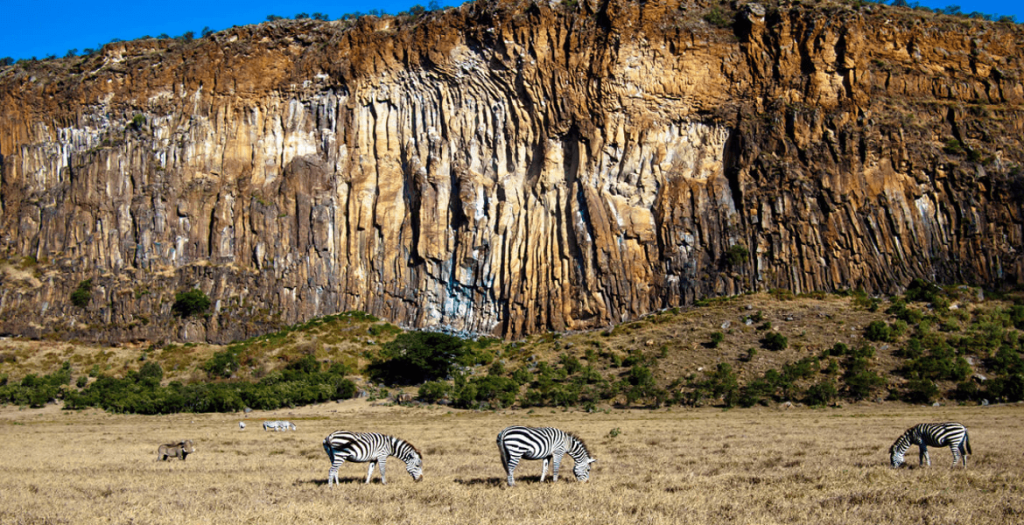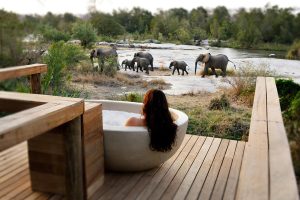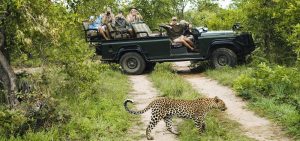CLICK TO BOOK A HELL’S GATE N.P SAFARI
Why Is It Called Hell’s Gate National Park?
Why is it called hell’s gate: Are curious about why is it called hell’s Gate National Park? Find out the thrilling story behind its fiery name, from towering cliffs and steaming vents to its deep ties with Maasai legend.
Nestled in the heart of Kenya’s Rift Valley, Hell’s Gate National Park is one of the most unique and breathtaking wildlife parks in Africa.
Unlike many other parks in Kenya, Hell’s Gate is known for its dramatic landscapes, towering cliffs, deep gorges, and geothermal activity rather than an abundance of large wildlife.
The park’s eerie yet striking scenery and history contribute to its ominous yet fascinating name. But why is it called Hell’s Gate National Park? This article explores the origins of its name, its history, and what makes this park a must-visit destination.
The Origin of the Name “Hell’s Gate”
The name Hell’s Gate was first recorded in the late 19th century by two explorers, Fischer and Thomson, who were mapping out parts of the Rift Valley.
They came across a narrow break in the cliffs that led into what is now the park, a passage that looked like an entrance to another world.
The rugged cliffs, steam rising from underground geothermal vents, and the deep gorges inspired them to name it “Hell’s Gate.”
At the time, the region was also believed to be an active area of geothermal activity that created a dramatic, almost hellish appearance, adding to the name’s origins.
Over time, the name stuck, and when the park was officially established in 1984, it was designated as Hell’s Gate National Park.
Geological Significance
Hell’s Gate’s name is deeply tied to its geology, a product of the Great Rift Valley’s tectonic activity. The park lies between Lake Naivasha and the extinct volcanoes Longonot and Suswa, in a region shaped by millions of years of volcanic eruptions, faulting, and erosion.
The Ol Njorowa Gorge, the park’s namesake, was carved by water from a prehistoric lake, creating a narrow, red-walled canyon that stretches through the park’s heart.
This gorge, along with volcanic plugs like Fischer’s Tower and Central Tower, and obsidian formations from cooled lava, showcases the area’s dynamic geological history.
The park’s geothermal activity is another key factor in its name. Underground heat from the now-extinct Olkaria volcano powers steaming vents and hot springs, some hot enough to cause burns.
The Olkaria Geothermal Station, the first of its kind in Africa, harnesses this energy, producing about 25% of Kenya’s electricity.
The sight of belching steam plumes and sulfuric waters in the gorge likely contributed to the “hellish” imagery that inspired the park’s name.
Overview of Hell’s Gate National Park
Established in 1984 under the Kenya Wildlife Service (KWS), Hell’s Gate National Park is one of Kenya’s smaller protected areas, covering 68.25 square kilometers in Nakuru County, approximately 90 kilometers northwest of Nairobi.
Its proximity to the capital (1.5–2 hours by road) and Lake Naivasha (15 km from Naivasha town) makes it an accessible destination for day trips or overnight adventures.
The park’s semi-arid climate, with warm days (20–30°C) and cool nights, and its location at 1,900 meters above sea level, create ideal conditions for outdoor activities.
Unlike most Kenyan national parks, Hell’s Gate is unique for allowing visitors to explore on foot or by bicycle, thanks to the absence of significant predator populations like lions or cheetahs.
While leopards and hyenas are occasionally sighted, the park is considered safe for unguided activities, making it a haven for thrill-seekers and nature lovers.
Its stunning landscapes, rich biodiversity, and cultural attractions, such as the Maasai Cultural Center, further enhance its appeal.

Key Features and Attractions in Hell’s Gate National Park
Ol Njorowa Gorge
The park’s centerpiece, the Ol Njorowa Gorge, is a narrow, water-sculpted canyon with towering red cliffs. It stretches through the park, offering a thrilling hiking experience with slippery paths, volcanic rocks, and hot springs.
Due to flash flood risks, access has been restricted since 2019, and a guide is mandatory (KSh 2,000–6,000 depending on the hike duration).
The gorge’s dramatic beauty inspired scenes in The Lion King (1994) and Lara Croft: Tomb Raider – The Cradle of Life (2003), making it a cinematic landmark.
Geothermal Activity – A Fiery Landscape
One of the most distinctive features of Hell’s Gate National Park is its geothermal activity. The park sits on the floor of the Great Rift Valley, an area known for intense volcanic and tectonic movements. The presence of hot springs, geysers, and steaming vents further adds to the illusion of an entrance to hell.
One of the most famous geothermal spots in the park is the Hell’s Gate Gorge, where steam continuously rises from underground vents, creating an eerie atmosphere.
The hot, sulfurous water flows through the gorge, carving out spectacular rock formations over thousands of years. The geothermal activity in the region is so intense that KenGen, Kenya’s main electricity producer, has established a geothermal power station nearby, harnessing energy from underground steam.
Towering Cliffs and Gorges
The dramatic landscapes of Hell’s Gate National Park are among its most defining features. The park is home to towering rock formations such as Fischer’s Tower and Central Tower, which rise dramatically against the Rift Valley’s backdrop.
These formations were shaped by volcanic activity and erosion, creating the jagged, otherworldly scenery that continues to fascinate visitors.
The Hell’s Gate Gorge is another highlight of the park. This deep, winding gorge has been sculpted by water and geothermal forces over thousands of years, creating a labyrinth of narrow canyons, caves, and steep rock walls.
Walking through the gorge feels like stepping into a different realm, reinforcing the idea that this place truly resembles an entrance to an underworld.
Myths and Local Folklore
The Maasai people, who have lived in this region for centuries, have their own interpretations of Hell’s Gate. According to Maasai folklore, the area was once home to a powerful and fiery spirit, and the rising steam from the ground was believed to be evidence of its presence.
Some stories say the steam represents the spirits of ancestors communicating with the living. Others believe that the gorges were formed by supernatural forces, adding to the mystique of the landscape.
Additionally, the area has historical significance as it was once a hunting ground for the Maasai, who would guide their livestock through the narrow gorges to find water and grazing land.
Wildlife and Unique Ecosystem
Unlike many other Kenyan national parks, Hell’s Gate is not primarily known for its wildlife. However, it is home to a variety of animals, including zebras, giraffes, gazelles, warthogs, and baboons. The park also has some predators such as leopards and hyenas, though they are rarely seen.
One of the most fascinating aspects of Hell’s Gate is its birdlife, particularly raptors. The park is a prime location for spotting vultures, eagles, and augur buzzards, which nest on the cliffs.
The towering rock formations provide perfect perches for these birds, enhancing the wild and untamed atmosphere of the park.
Maasai Cultural Center
Located within the park, this center provides insights into Maasai culture through traditional dances, crafts, and educational talks. Visitors can engage with Maasai guides, like Lekishon, who share stories about their heritage and the park’s history, enriching the cultural experience.
Scenic Landscapes
The park’s landscape, shaped by volcanic ash from Mount Longonot’s eruption over 100 years ago, features towering cliffs, scrub-clad volcanoes, and obsidian caves.
Notable viewpoints include Lake View Point, Hell’s Kitchen, and Kapartania View Point, offering stunning vistas of the Rift Valley.

Hell’s Gate in Popular Culture
Hell’s Gate National Park has also captured the imagination of filmmakers and storytellers. It served as inspiration for the setting of Disney’s “The Lion King”, with many of the movie’s landscapes resembling the park’s cliffs and gorges.
The park’s rugged beauty has made it a prime location for adventure activities and photography, drawing thousands of tourists each year.
Adventure Activities in Hell’s Gate
Today, Hell’s Gate National Park is one of Kenya’s top adventure destinations. Some of the most popular activities include:
1. Hiking
The park’s trails, such as those at Hobley’s Volcano and Ol Basta Rock Tower, cater to various fitness levels. The Ol Njorowa Gorge hike (short or long options) is a highlight, featuring undulating sandstone walls and hot springs, though it requires a guide due to safety concerns. The Mount Longonot trail, accessible from Hell’s Gate, offers a challenging hike along the volcano’s base.
2. Cycling
Cycling through the park’s 16-km main route (Elsa Gate to Central Tower and back) is a bucket-list experience, allowing close encounters with zebras and giraffes.
Bike rentals are available at the gate or nearby lodges (KSh 500–1,000/day). The 14-km Buffalo Circuit offers views of Mount Longonot but includes steep sections. The bumpy, dusty roads require caution, especially in the afternoon sun.
3. Rock Climbing
Fischer’s Tower and other cliffs attract climbers of all skill levels. Guided climbs, arranged through tour operators like Kambu Campers, provide equipment and safety instruction. The activity is thrilling but requires proper gear and experience due to the challenging terrain.
4. Game Drives and Walks
Guided game drives or walks offer opportunities to spot wildlife and photograph the park’s landscapes. The absence of large predators makes walking safaris uniquely safe, with guides enhancing the experience with knowledge of flora, fauna, and Maasai culture.
5. Bird Watching
With over 100 bird species, Hell’s Gate is ideal for birders. The Mervyn Carnelley Raptor Hide allows close-up views of vultures and eagles.
Binoculars are recommended to spot species like the endangered Chandler’s mountain reedbuck or rare klipspringer.
6. Geothermal Spa and Tours
The Olkaria Geothermal Spa offers a relaxing soak in naturally heated pools, perfect after a day of hiking or cycling. Educational tours of the Olkaria Geothermal Station highlight Kenya’s renewable energy efforts.
7. Cultural Experiences
Visiting the Maasai Cultural Center or engaging with Maasai guides provides a deep dive into local traditions. Guides like Lekishon (+254 111 789 632) or Robert (+254 725 894 994) offer personalized tours, sharing stories about Maasai life and the park’s history.
Practical Information for Visitors
Getting There
- By Road: From Nairobi, take the A104 Uplands Road to Naivasha, then Moi South Lake Road to Elsa Gate (25 km from the junction). The 90-km journey takes 1.5–2 hours, though traffic on the Rift Valley escarpment can cause delays. Public buses or matatus from Nairobi to Naivasha are affordable, followed by local transport to the park. Taxis or private cars cost KSh 10,000 or more.
- By Air: Short flights from Wilson Airport to Naivasha (under 1 hour) are available but expensive. From Naivasha, arrange a taxi or tour to the park.
Hell’s Gate National Park Entry Fees (2025)
- Adults: $26 (non-residents), KSh 300 (Kenyan residents)
- Children (3–17): $17 (non-residents), KSh 200 (residents)
- Camping: KSh 500–1,000 per person/night
- Vehicle Entry: KSh 300–1,500 (based on size)
- Bicycle Rental: KSh 500–1,000/day Fees are payable online via the KWS eCitizen platform (kws.ecitizen.go.ke) or at the gate (credit card only, no cash).
Best Time to Visit
- Dry Seasons (June–October, January–February): Ideal for hiking, cycling, and wildlife viewing due to clear trails and milder weather (20–30°C). Rainfall is minimal (200–700 mm annually).
- Wet Seasons (March–May, November–December): Rain can make trails slippery, and the gorge may close due to flash flood risks. Check with rangers before hiking.
Accommodation
- Inside the Park: Three basic campsites (Endachata, Naiburta, and Oldubai) offer budget-friendly options (KSh 500–1,000/night). Bring camping gear, food, and water, as facilities are minimal.
- Nearby: Naivasha offers a range of accommodations, from budget campsites to luxury lodges like Safa Lodge. Booking platforms like Booking.com or direct lodge websites are recommended.
What to Bring
- Comfortable hiking/cycling shoes and clothing
- Sunscreen, sunglasses, and a hat for sun protection
- Insect repellent (mosquitoes can be present)
- Binoculars for bird watching
- Camera for photography
- Water and snacks (available at Elsa Gate or Ranger’s Post)
- First aid kit and reserve car fuel for longer stays
Safety and Regulations
- Guides: Mandatory for the Ol Njorowa Gorge due to flash flood risks. Local Maasai guides (KSh 2,000–6,000) or KWS rangers (KSh 2,000 for half-day) are available. Bargaining is possible with local guides.
- Wildlife: While predators are rare, maintain a safe distance from animals like buffaloes.
- Flash Floods: Avoid the gorge during heavy rain. Look for emergency exits during hikes.
- Bikes: Park bikes at the gorge entrance, where Maasai locals will watch them.
- Health: Stay hydrated and use sunscreen, as the semi-arid climate is intense.
Conservation and Environmental Challenges
Despite its beauty, Hell’s Gate National Park faces several environmental challenges. The impact of climate change has altered rainfall patterns, affecting the gorges and wildlife.
Increased geothermal energy extraction in the area also poses risks to the park’s delicate ecosystem. Conservation efforts are ongoing to balance sustainable energy use while preserving the park’s natural beauty and biodiversity.
Cultural and Cinematic Significance
Hell’s Gate’s striking landscapes have made it a cultural and cinematic icon. The park inspired the setting for Disney’s The Lion King, with animators visiting to capture its cliffs, gorges, and plains. The Ol Njorowa Gorge also featured in Lara Croft: Tomb Raider – The Cradle of Life, highlighting its global appeal.
The Maasai Cultural Center offers a window into the traditions of the Maasai people, who have lived in the region for centuries. Their stories, such as the legend of Fischer’s Tower, add depth to the park’s allure.
Tips for an Unforgettable Visit
- Plan a Day Trip or Overnight: Hell’s Gate is perfect for a day trip from Nairobi, but camping or staying in Naivasha allows more time to explore. Combine with a boat tour on Lake Naivasha or a visit to Crescent Island.
- Hire a Local Guide: Local guides offer personalized tours, sharing Maasai history and park insights. Avoid park guides if budget is a concern, as they can be pricier.
- Cycle Early: Start biking in the morning to avoid the afternoon heat and dust. The 16-km main route is manageable for most fitness levels.
- Check Gorge Access: Contact KWS (kws.go.ke) to confirm if the Ol Njorowa Gorge is open, as closures occur during rainy seasons.
- Respect the Environment: Stick to trails to protect the fragile ecosystem and avoid disturbing wildlife.
- Capture the Scenery: Bring a camera for the park’s alien-like landscapes, especially at sunrise or sunset. The “talking wall” cliffs offer fun echo effects for photos or videos.
Critical Considerations
While Hell’s Gate is celebrated for its accessibility and adventure, some sources overstate its wildlife diversity compared to parks like Maasai Mara or Amboseli.
The park’s appeal lies in its scenery and activities, not abundant game, so manage expectations if seeking a classic safari.
The geothermal plants, while a conservation win, have drawn criticism for industrializing parts of the park, with noise and dust affecting the wilderness experience.
In conclusion, Hell’s Gate National Park earns its name from its dramatic landscapes, geothermal activity, and historical significance.
The towering cliffs, steaming geysers, and deep gorges create an atmosphere that feels almost supernatural, resembling an entrance to the underworld.
Whether it is the result of volcanic forces, Maasai folklore, or early explorers’ descriptions, the park’s name is fitting for such a striking and unique landscape.
For adventurers, nature lovers, and culture enthusiasts, Hell’s Gate National Park offers an unforgettable experience, living up to its name as a place of fiery landscapes, rugged beauty, and untamed wilderness.




